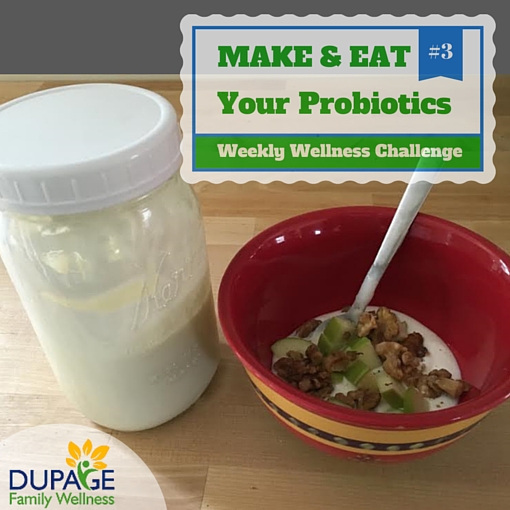 “Health-ify” Your Favorite Meal
“Health-ify” Your Favorite Meal
There are some foods that we absolutely LOVE, but these foods might not be the healthiest choice.
This begs the question – what are “healthy” foods?
I think of healthy foods as the foods that come from only real food ingredients and are rich in nutrients to nourish and fuel your body. There are TWO key components:
- Made from real, unprocessed ingredients AND
- Rich in nutrients.
Generally, if it grew in the ground or was once alive, it is probably nutritious. If it was made in a factory, then think about it more carefully.
To make your favorite foods healthier: Remove the processed ingredients and add more nutrient dense ingredients.
How does this work?
We were having friends over for dinner the other day and I planned to make roasted chicken thighs, asparagus, and sweet potatoes, but I also wanted to include a dessert. I love brownies, but generally brownies are full of sugar and other processed ingredients, especially if you buy the boxed mix. So with help from Google, and little tweaking, I came up with a brownie that satisfied that sweet tooth, contained mostly real ingredients full of nutrients, and was a hit with our dinner guests. See recipe below.
There are many foods that people often think must be included in a meal, such as bread, pasta, rice, potatoes, or tortillas. While these might seem like healthy choices, they tend to be filler foods that are high in calories and carbohydrates, and low in nutrients. Skip them, and replace as follows:
Substitute / Add Vegetables
As a rule of thumb, at least half, if not 2/3 or 3/4 of your plate should be vegetables. Try these ideas to add more veggies:
- Add more vegetables to your family’s favorite soup or casserole. It’s amazing how well veggies cook down and you can add lots of vegetables without changing the dish. Soon your family will like it better this way. Note: This could mean adding more of the same vegetable that the recipe calls for or others that you have on hand.
- Remove the bread, and replace with greens, like spinach. Your sandwich becomes a salad. Similarly, replace tortillas with greens to make taco salad!
- Replace pasta with spaghetti squash, spiralated squash, or other veggies.
- Replace rice, mashed potatoes, or pizza crust with cauliflower rice or mashed cauliflower, or cauliflower crust . This may sound strange but it’s a GREAT way to substitute a food with little nutrients to one that is more nutrient dense and still tastes great!
Make it from Scratch
It is easy to get in the habit of using packaged products because it is easier or you don't know how to make it from scratch. Actually, it's often not that hard to make it from scratch, you just need to be brave, find a recipe, and try it.
- Make homemade mayo – Replace those, processed vegetable oils with healthy fats and natural ingredients. Use your mayo as a base in salad dressing or chicken/tuna/egg salad.
- Replace the canned "cream of xyz" soup in your family favorite casserole and make the real stuff – like this recipe.
Healthified Brownies
In this brownie recipe, the flour, sugar, and vegetable oil are replaced with avocados and bananas.
Ingredients:
- 2 Avocados
- 2 Bananas
- 2 Eggs
- ½ Cup Cocoa Powder
- ¼ Cup Raw Honey
- 1 Tsp Baking soda
- ½ Cup Dark Chocolate chips (Optional)
Method:
Blend avocados, bananas, eggs, cocoa powder, honey, and baking soda – an immersion blender or food processor work well. Stir in chocolate chips if desired Pour into a greased (I use coconut oil) 8x8 baking dish. Bake at 350 for 25-30 min.
This week, use these tips to “health-ify” one of your favorite meals.
Let us know how it goes and share more ideas on our facebook page!
Joelle Kurczodyna, NTP

Eat The Rainbow
It is easy it is to get stuck in a rut, eating the same foods. This week, focus on branching out! As you grocery shop, admire at all the colors in the produce department. Buy something new! Fill your cart with foods of different colors.
Why is eating a variety of colors important?
Foods of each color have different nutrients and properties. We need ALL of the colors to get all the nutrients that our bodies need to be healthy.
Red
Red produce is known for its cancer fighting properties. The reds provide an abundance of antioxidants, including high doses of vitamin C, flavonoids, lycopene, and anthocyanin.
Examples of RED: Apples, beets, bell peppers, red cabbage, cayenne peppers, cherries, cranberries, grapes, pomegranates, radicchio, radishes, raspberries, rhubarb, ruby red grapefruit, strawberries, tomatoes, watermelon.
Orange
Orange fruits and vegetables are known for their beta-carotene, which is the precursor to vitamin A. This is essential for night vision and also neutralizes free radicals in the body making it crucial for boosting the immune system. Orange vegetables are another powerhouse of Vitamin C.
Examples of ORANGE: Butternut squash, cantaloupe, carrots, guava, loquats, kumquat, mandarin, mango, nectarines, orange bell pepper, oranges, papaya, persimmon, peach, pumpkin, sweet potato, tangerines, winter squash.
Yellow
We all love this sunny color. Yellow fruits and vegetables are bursting with carotenoids and bioflavanoids and more vitamin C. Studies have found that eating YELLOW is beneficial to your heart, vision, digestion and immune system.
Examples of YELLOW: Lemons, bananas, yellow summer squash, delicata squash, pineapple, star fruit, mangoes, endive, yellow peppers, onions, chamomile, yellow tomatoes, turmeric, mustard seeds, spaghetti squash, Crenshaw melon
Green
If you had to pick one color to provide you with the most nutrient density, green is your color! Eating dark greens are known for:
- Naturally reducing cholesterol
- Providing antioxidants with immune system boosters and anti-cancer properties
- Providing mood boosting B vitamins
- Preventing osteoporosis more effectively than milk. Greens provide calcium along with the potassium, magnesium and other minerals to build strong bones.
Examples of GREEN: Arugula, bok choy, broccoli, cabbage, brussel sprouts, collard greens, lettuces, kale, mustard greens, escarole, turnip greens, beet greens, watercress, spinach, swiss chard, parsley, cilantro, artichokes, green summer squash, cucumbers, kiwi, celery.
Blue / Purple
The USDA has named blueberries the fruit highest in antioxidants. The powerful antioxidants present in blue and purple fruits and veggies help prevent oxidative cell damage, thus reducing the risk of Alzheimer’s, heart disease, and cancer. Anthocyanin in dark blue and purple fruits and vegetables helps to improve memory, and the flavonoids present help to metabolize bacteria in the arteries and improve circulation to reduce the risk of heart disease. Furthermore, the antioxidants neutralize free radicals, preventing cell damage and cancer causing tumors. One added benefit of the blues and purples are the rich flavonoids, which help prevent urinary tract infections.
Examples of BLUE/PURPLE: Blueberries, blackberries, cranberries, eggplant, figs, plums, purple potatoes, grapes, prunes.
This week aim to fill your grocery cart with a rainbow of produce (no, Skittles do not count). Your goal is to eat at least 2 colors at each meal! Let us know how it goes on our facebook page.
Joelle Kurczodyna, NTP
 Everyone should consume probiotics to maintain good digestion and gut health. You may think that this means taking a pill or supplement, but my preferred method of ingesting these "good" bacteria is through the food that you eat! In fact, probiotics were part of the regular diet in previous generations.
Everyone should consume probiotics to maintain good digestion and gut health. You may think that this means taking a pill or supplement, but my preferred method of ingesting these "good" bacteria is through the food that you eat! In fact, probiotics were part of the regular diet in previous generations.
Probiotics are beneficial bacteria contained in fermented foods. Before refrigerators and modern food storage, fermenting was used to preserve food. During fermentation, natural bacteria feed on the sugars and starches in the food creating lactic acid. Lactic acid not only preserves the food, it also makes it more digestible and preserves and increases beneficial enzymes, nutrients, and beneficial bacteria (probiotics). As convenience and processed foods have overtaken our pantries, we have stopped eating these healthful and traditional fermented foods, and our probiotic consumption has declined, as well.
Why Make and Eat Your Own Fermented Foods
- Increase probiotics. Probiotics provide your digestive system with bacteria that has been known to have tremendous benefits including improving your immune system, helping digestion, balancing hormones, and even slowing or eliminating disease.
- Makes food more digestible and easily absorbed. The process of fermentation begins to breakdown food naturally, making it easier to digest. The fermented food also provides the bacteria and digestive enzymes to help your body absorb all the good nutrients packed other real food that you eat.
- Save money. Finding a good brand of fermented foods that does not contain added ingredients is often difficult, and usually these products are expensive. However, it is budget friendly to make your own fermented foods, using a few simple ingredients. You would no longer purchase probiotic supplements, and the health benefits of probiotics could save you future medical expenses.
What fermented food to make?
It is easy to ferment most fruits and vegetables by cutting them up, mixing them with salt and spices, pounding them to release juices, and then storing them in an air tight container. You can find hundreds of recipes for doing this by searching "lactofermented" with the name of the food you would like to ferment.
Two super simple fermented foods that are a part of our regular diet are homemade yogurt and sauerkraut.
Homemade Crockpot Yogurt
Ingredients:
- ½ gallon of whole fat organic milk
- ½ cup of PLAIN yogurt (only ingredients are milk and cultures) Read the ingredients, and you will see the cultures listed.
Note: Typical flavored yogurt, including vanilla yogurt, does not have these cultures. Learn more about yogurt here.
Directions:
- Pour ½ gallon of milk into crockpot and cook on LOW.
- After 2.5 hours turn crockpot off and let sit for 3 hours without removing the lid.
- Once the additional 3 hours has passed, quickly remove lid and stir in ½ cup of plain yogurt into the warm milk.
- Set lid back on and wrap crockpot in two large bath towels.
- Let sit on counter for around 12 hours, or overnight.
- Store yogurt in glass quart size mason jars. The yogurt will continue to thicken to desired texture after being refrigerated for 4-6 hours.
Add your favorite fresh fruits and nuts. Enjoy!
Don't forget to reserve 1/2 cup to start your next batch.
Traditional Sauerkraut
Ingredients:
- 1 head of cabbage
- 2 tbsp sea salt
Directions:
- Core and shred cabbage.
- In a large bowl mix cabbage with salt.
- Pound with meat hammer or use your hands to massage juices from cabbage. This can take 10-20 minutes, be patient!
- Place cabbage in juices into a wide mouth mason jar making sure that the juices cover the cabbage and that you leave at least one inch of head space at the top of the jar.
- Cover tightly and store counter for three days then move to refrigerator.
What other fermented foods do you eat? Kimchi? Pickle your own cucumbers? Beets? Talk to us about it on our facebook page, and good luck with this week's challenge.
 Spring Cleaning…Naturally!
Spring Cleaning…Naturally!

 “Health-ify” Your Favorite Meal
“Health-ify” Your Favorite Meal Walk More!
Walk More!
 Everyone should consume probiotics to maintain good digestion and gut health. You may think that this means taking a pill or supplement, but my preferred method of ingesting these "good" bacteria is through the food that you eat! In fact, probiotics were part of the regular diet in previous generations.
Everyone should consume probiotics to maintain good digestion and gut health. You may think that this means taking a pill or supplement, but my preferred method of ingesting these "good" bacteria is through the food that you eat! In fact, probiotics were part of the regular diet in previous generations.